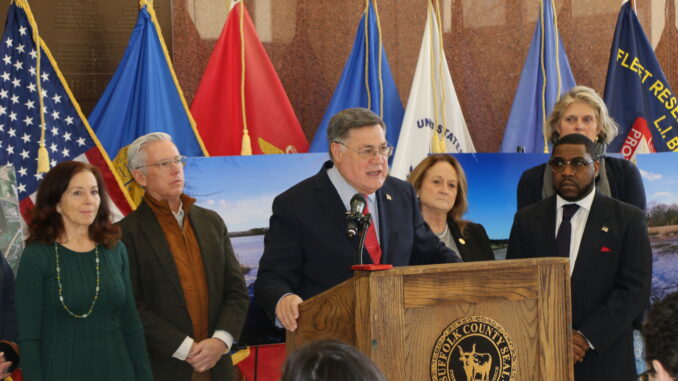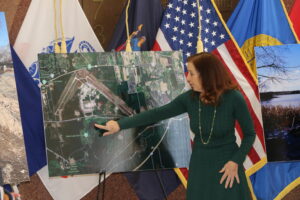
UPDATE: The EPA has responded to our requests.
By Hank Russell
Local elected officials, environmental activists, health officials and concerned residents took part in a press conference at the H. Lee Dennison Building on February 21 calling on the U.S. Navy to clean up the former Grumman site in Calverton of dangerous chemicals such as perfluoroalkyl substances (PFAS) and 1,4-dioxane. Suffolk County Executive Ed Romaine blasted the Navy for failing to perform any remediation on the site.
The issue is close to Romaine, who lives in the area. He previously served as a county legislator in which his district covered Manorville and parts of Riverhead. He was also county clerk and supervisor of the Town of Brookhaven, where part of Manorville is located.
The contamination has “gotten so bad,” he said, that the chemicals made its way into the Peconic River, which has been used for fishing. It has also resulted in a “fish advisory,” in which no one is recommended to eat more than one fish per month.
“I know the community,” Romaine said. “I know what the people are going through. These people are being victimized by the Navy. … It makes my blood [boil]. Shame on them! I’m aggravated because this is government at its worst.” He also said that he will “use the clout of my office” to make sure the Navy fixes the problem.
Romaine sent a letter to Acting Navy Secretary Terence G. Emmert about the situation. In addition to calling on the Navy to implement a remediation plan and start cleaning up the property, Romaine also demanded that the former Grumman property be designated as an inactive Superfund site. A copy of the letter — obtained by Long Island Life & Politics — was also submitted to U.S. Environmental Protection Agency (EPA) Administrator Lee Zeldin, U.S. Representative Nick LaLota (R-Rocky Point) and U.S. Senator Chuck Schumer.
LILP reached out to the U.S. Navy and the EPA for this story. The Navy did not respond.
EPA spokesperson Molly Vaseliou said that groundwater remediation is taking place both on and off the former Grumman site under the New York State Department of Environmental Conservation’s (NYS DEC) authorized hazardous waste program. “The EPA will continue to coordinate with the NYS DEC and the responsible parties to progress with the cleanup in accordance with federal requirements,” she said.

Adrienne Esposito, executive director of the Citizens Campaign for the Environment, said the amount of chemicals measured in the water comes out to 2,020 parts per trillion (ppt) — far exceeding the state’s recommended levels of 10 ppt. “The U.S. Navy is supposed to be protecting its people, not poisoning their people,” she said.
She also accused the Navy of hiding its findings on the property from the Suffolk County Department of Health regarding the extent of the contamination. Both agencies are supposed to share data, Esposito said hiding the data “only happens when the agency has something to hide. We need transparency.”
As for Romaine’s request to make this a Superfund site, Vaseliou replied, “EPA typically does not list sites on the Superfund (National Priorities List [NPL]) if they are being addressed under the Resource Conservation and Recovery Act (RCRA) hazardous waste program,” which “governs the management of solid waste, hazardous waste facilities and underground storage tanks holding petroleum products or certain chemicals.”
Instead of placing sites on the Superfund list, “[i]t is the EPA’s policy to defer placing sites on the NPL that can be comparably addressed under RCRA Subtitle C Corrective Action (i.e., hazardous waste cleanup) authorities. NYSDEC has been authorized by EPA to administer this RCRA program.”
Deputy County Executive Jennifer Juengst said it was “outrageous” that the data was not being shared with the county. She also put some of the blame on the NYS DEC. There was outcry from Juengst and Riverhead Town Councilman Bob Kern that the state wasn’t doing a good enough job on oversight. “There’s no reason to wait one more day.”
Long Island Life & Politics reached to the DEC. The agency replied in a statement, “DEC is overseeing the comprehensive investigation of the Naval Weapons Industrial Reserve Plant (NWIRP) Calverton site through the agency’s regulatory authority under the Resource Conservation and Recovery Act (RCRA) and State Superfund (SSF) programs.”
The agency also noted that the Navy is investigating the nature and extent of contamination of PFAS and potential source areas both on and off the Calverton property. “DEC will continue to work with state and federal partners and the community to ensure a comprehensive investigation and cleanup.”
Esposito also called on the Navy to give Suffolk $2 million to hook up clean drinking water to the residents of River Road, and use a granulated carbonation system to get rid of the PFAS in the water. “It shouldn’t have to be so hard, especially when it’s a federal agency,” she said. “This should be done expeditiously; instead, they ar removing at a pre-global warming glacial pace.”
Also at the press conference was Kelly McClinchey, a Manorville resident impacted by the contamination. “We’ve been using bottled water for a couple of years,” she said. “That’s how it’s been. … It’s unacceptable. … I can’t say the Navy didn’t do anything; they did nothing.”
Romaine cited McClinchy’s story as one of many being told in the Manorville area. “Imagine that water being used to bathe your newborn, to give your child a drink of water, to boil spaghetti …”
He told the Navy, “Now is the time to step up to the plate and clean up the mess you left.”

